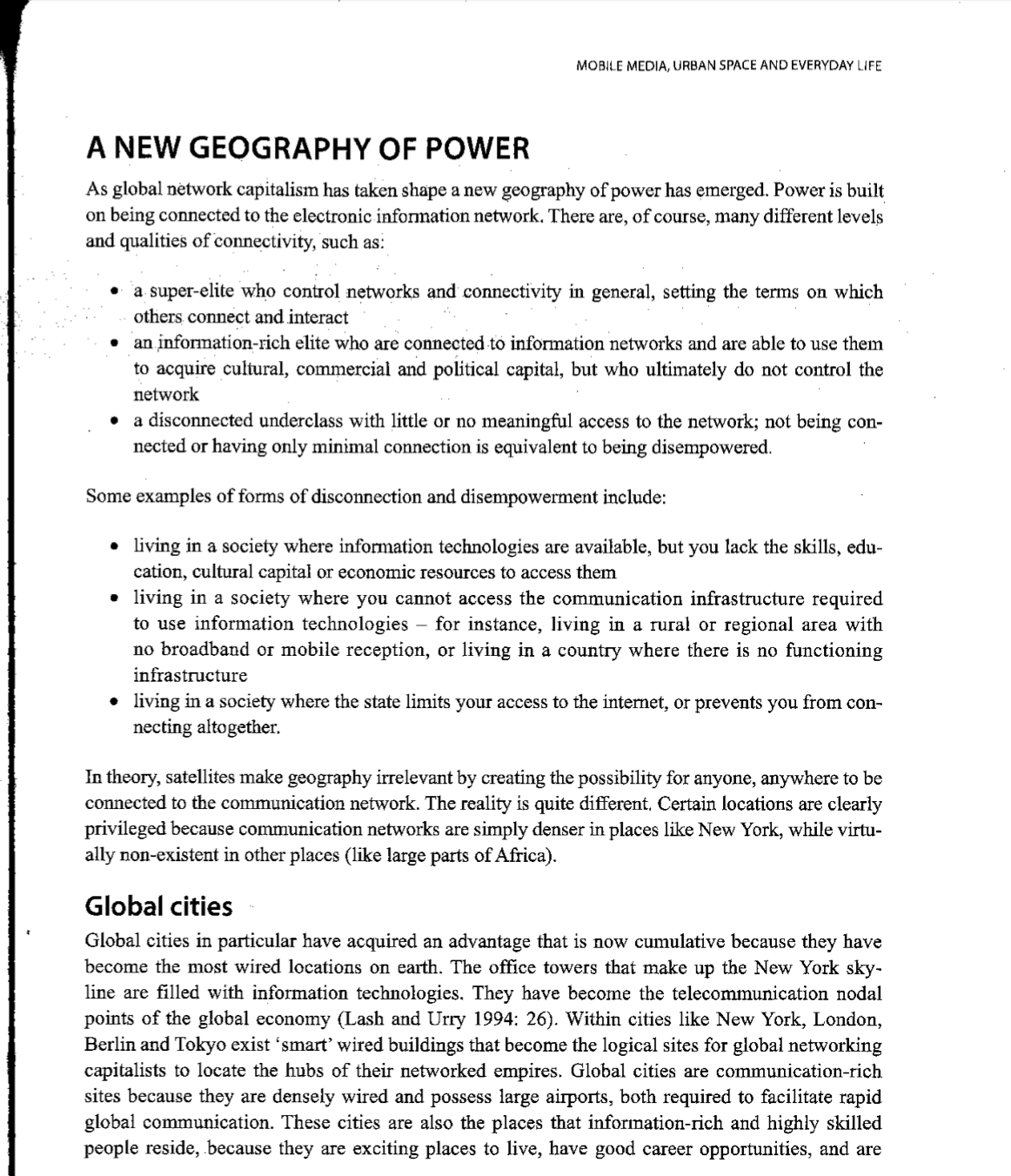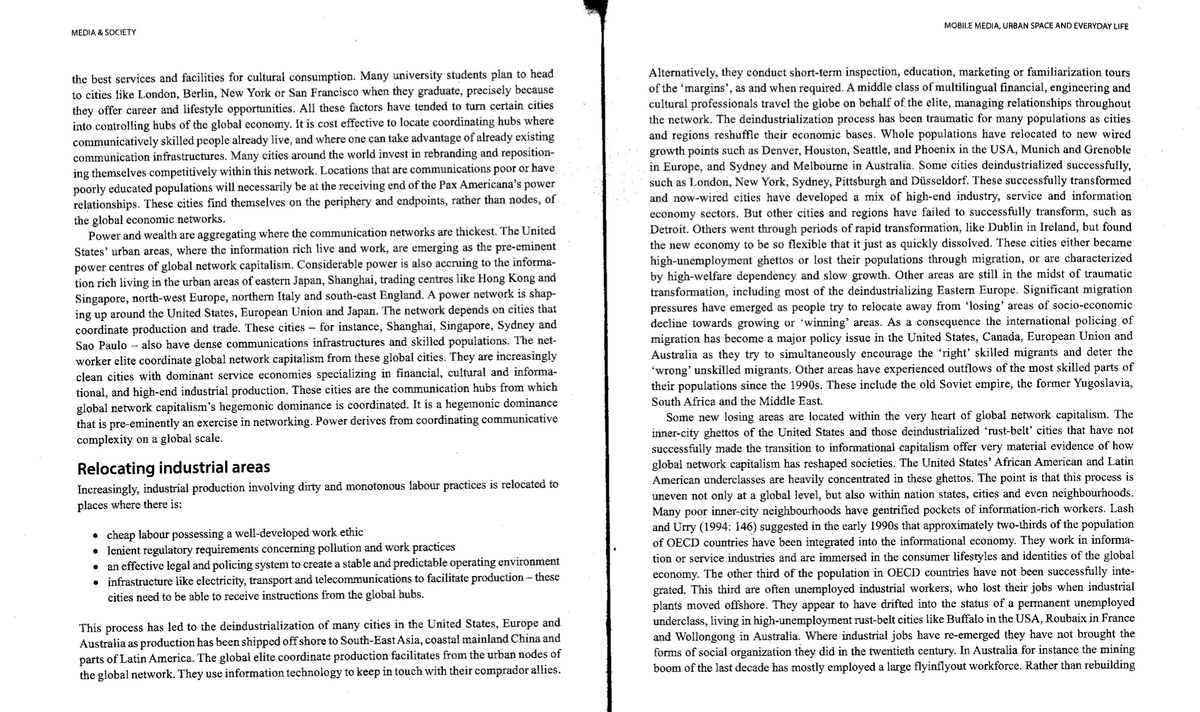Using Ch. 12 in the Carah and Louw (2015) text as a base for your response, discuss how the electronic information network and media connectivity plays a vital role through which geographies of power have emerged in global networked capitalism. Use four recent examples from within an Indian context (from your own hometown or city, perhaps) to clearly explain your answer.
Using Ch. 12 in the Carah and Louw (2015) text as a base for your response, discuss how the electronic information network and media connectivity plays a vital role through which geographies of power have emerged in global networked capitalism. Use four recent examples from within an Indian context (from your own hometown or city, perhaps) to clearly explain your answer.
Principles Of Marketing
17th Edition
ISBN:9780134492513
Author:Kotler, Philip, Armstrong, Gary (gary M.)
Publisher:Kotler, Philip, Armstrong, Gary (gary M.)
Chapter1: Marketing: Creating Customer Value And Engagement
Section: Chapter Questions
Problem 1.1DQ
Related questions
Question
Using Ch. 12 in the Carah and Louw (2015) text as a base for your response, discuss how the electronic information network and media connectivity plays a vital role through which geographies of power have emerged in global networked capitalism.
Use four recent examples from within an Indian context (from your own hometown or city, perhaps) to clearly explain your answer.

Transcribed Image Text:MOBILE MEDIA, URBAN SPACE AND EVERYDAY LIFE
A NEW GEOGRAPHY OF POWER
As global nėtwork capitalism has taken shape a new geography of power has emerged. Power is built
on being connected to the electronic information network. There are, of course, many different levels
and qualities of connectivity, such as:
a super-elite who control networks and connectivity in general, setting the terms on which
others connect and interact
an information-rich elite who are connected to information networks and are able to use them
to acquire cultural, commercial and political capital, but who ultimately do not control the
network
a disconnected underclass with little or no meaningful access to the network; not being con-
nected or having only minimal connection is equivalent to being disempowered.
Some examples of forms of disconnection and disempowerment include:
• living in a society where information technologies are available, but you lack the skills, edu-
cation, cultural capital or economic resources to access them
• living in a society where you cannot access the communication infrastructure required
to use information technologies – for instance, living in a rural or regional area with
no broadband or mobile reception, or living in a country where there is no functioning
infrastructure
• living in a society where the state limits your access to the internet, or prevents you from con-
necting altogether.
In theory, satellites make geography irrelevant by creating the possibility for anyone, anywhere to be
connected to the communication network. The reality is quite different, Certain locations are clearly
privileged because communication networks are simply denser in places like New York, while virtu-
ally non-existent in other places (like large parts of Africa).
Global cities
Global cities in particular have acquired an advantage that is now cumulative because they have
become the most wired locations on earth. The office towers that make up the New York sky-
line are filled with information technołogies. They have become the telecommunication nodal
points of the global economy (Lash and Urry 1994: 26). Within cities like New York, London,
Berlin and Tokyo exist 'smart' wired buildings that become the logical sites for global networking
capitalists to locate the hubs of their networked empires. Global cities are communication-rich
sites because they are densely wired and possess large airports, both required to facilitate rapid
global communication. These cities are also the places that information-rich and highly skilled
people reside, because they are exciting places to live, have good career opportunities, and are

Transcribed Image Text:MOBILE MEDIA, URBAN SPACE AND EVERYDAY LIFE
MEDIA & SOCIETY
the best services and facilities for cultural consumption. Many university students plan to head
to cities like London, Berlin, New York or San Francisco when they graduate, precisely because
they offer career and lifestyle opportunities. All these factors have tended to turn certain cities
into controlling hubs of the global economy. It is cost effective to locate coordinating hubs where
communicatively skilled people already live, and where one can take advantage of already existing
communication infrastructures. Many cities around the world invest in rebranding and reposition-
ing themselves competitively within this network. Locations that are communications poor or have
poorly educated populations will necessarily be at the receiving end of the Pax Americana's power
relationships. These cities find themselves on the periphery and endpoints, rather than nodes, of
the global economic networks.
Power and wealth are aggregating where the communication networks are thickest. The United
States' urban areas, where the information rich live and work, are emerging as the pre-eminent
power centres of global network capitalism. Considerable power is also accruing to the informa-
tion rich living in the urban areas of eastern Japan, Shanghai, trading centres like Hong Kong and
Singapore, north-west Europe, northern Italy and south-east England. A power network is shap-
ing up around the United States, European Union and Japan. The network depends on cities that
coordinate production and trade. These cities – for instance, Shanghai, Singapore, Sydney and
Sao Paulo - also have dense communications infrastructures and skilled populations. The net-
worker elite coordinate głobal network capitalism from these global cities. They are increasingly
clean cities with dominant service economies specializing in financial, cultural and informa-
tional, and high-end industrial production. These cities are the communication hubs from which
global network capitalism's hegemonic dominance is coordinated. It is a hegemonic dominance
that is pre-eminently an exercise in networking. Power derives from coordinating communicative
complexity on a global scale.
Alternatively, they conduct short-term inspection, education, marketing or familiarization tours
of the 'margins', as and when required. A middle class of multilingual financial, engineering and
cultural professionals travel the globe on behalf of the elite, managing relationships throughout
the network. The deindustrialization process has been traumatic for many populations as cities
and regions reshuffle their economic bases. Whole populations have relocated to new wired
growth points such as Denver, Houston, Seattle, and Phoenix in the USA, Munich and Grenoble
in Europe, and Sydney and Melbourne in Australia. Some cities deindustrialized successfully,
such as London, New York; Sydney, Pittsburgh and Düsseldorf. These successfully transformed
and now-wired cities have developed a mix of high-end industry, service and information
economy sectors. But other cities and regions have failed to successfully transform, such as
Detroit. Others went through periods of rapid transformation, like Dublin in Ireland, but found
the new economy to be so flexible that it just as quickly dissolved. These cities either became
high-unemployment ghettos or lost their populations through migration, or are characterized
by high-welfare dependency and slow growth. Other areas are still in the midst of traumatic
transformation, including most of the deindustrializing Eastern Europe. Significant migration
pressures have emerged as people try to relocate away from ʻlosing' areas of socio-economic
decline towards growing or 'winning' areas. As a consequence the international policing of
migration has become a major policy issue in the United States, Canada, European Union and
Australia as they try to simultaneously encourage the 'right' skilled migrants and deter the
'wrong' unskilled migrants. Other areas have experienced outflows of the most skilled parts of
their populations since the 1990s. These include the old Soviet empire, the former Yugoslavia,
South Africa and the Middle East.
Some new losing areas are located within the very heart of global network capitalism. The
inner-city ghettos of the United States and those deindustrialized 'rust-belt' cities that have not
successfully made the transition to informational capitalism offer very material evidence of how
global network capitalism has reshaped societies. The United States' African American and Latin
American underclasses are heavily concentrated in these ghettos. The point is that this process is
uneven not only at a global level, but also within nation states, cities and even neighbourhoods.
Many poor inner-city neighbourhoods have gentrified pockets of information-rich workers. Lash
and Urry (1994: 146) suggested in the early 1990s that approximately two-thirds of the population
of OECD countries have been integrated into the informational economy. They work in informa-
tion or service industries and are immersed in the consumer lifestyles and identities of the global
economy. The other third of the population in OECD countries have not been successfully inte-
grated. This third are often unemployed industrial workers, who lost their jobs when industrial
plants moved offshore. They appear to have drifted into the status of a permanent unemployed
underclass, living in high-unemployment rust-belt cities like Buffalo in the USA, Roubaix in France
and Wollongong in Australia. Where industrial jobs have re-emerged they have not brought the
forms of social organization they did in the twentieth century. In Australia for instance the mining
boom of the last decade has mostly employed a large flyinflyout workforce. Rather than rebuilding
Relocating industrial areas
Increasingly, industrial production involving dirty and monotonous labour practices is relocated to
places where there is:
cheap labour possessing a well-developed work ethic
• lenient regulatory requirements concerning pollution and work practices
an effective legal and policing system to create a stable and predictable operating environment
• infrastructure like electricity, transport and telecommunications to facilitate production - these
cities need to be able to receive instructions from the global hubs.
This process has led to the deindustrialization of many cities in the United States, Europe and
Australia as production has been shipped off shore to South-East Asia, coastal mainland China and
parts of Latin America. The global elite coordinate production facilitates from the urban nodes of
the global network. They use information technology to keep in touch with their comprador allies.
Expert Solution
This question has been solved!
Explore an expertly crafted, step-by-step solution for a thorough understanding of key concepts.
Step by step
Solved in 2 steps

Recommended textbooks for you

Principles Of Marketing
Marketing
ISBN:
9780134492513
Author:
Kotler, Philip, Armstrong, Gary (gary M.)
Publisher:
Pearson Higher Education,

Marketing
Marketing
ISBN:
9781259924040
Author:
Roger A. Kerin, Steven W. Hartley
Publisher:
McGraw-Hill Education

Foundations of Business (MindTap Course List)
Marketing
ISBN:
9781337386920
Author:
William M. Pride, Robert J. Hughes, Jack R. Kapoor
Publisher:
Cengage Learning

Principles Of Marketing
Marketing
ISBN:
9780134492513
Author:
Kotler, Philip, Armstrong, Gary (gary M.)
Publisher:
Pearson Higher Education,

Marketing
Marketing
ISBN:
9781259924040
Author:
Roger A. Kerin, Steven W. Hartley
Publisher:
McGraw-Hill Education

Foundations of Business (MindTap Course List)
Marketing
ISBN:
9781337386920
Author:
William M. Pride, Robert J. Hughes, Jack R. Kapoor
Publisher:
Cengage Learning

Marketing: An Introduction (13th Edition)
Marketing
ISBN:
9780134149530
Author:
Gary Armstrong, Philip Kotler
Publisher:
PEARSON


Contemporary Marketing
Marketing
ISBN:
9780357033777
Author:
Louis E. Boone, David L. Kurtz
Publisher:
Cengage Learning